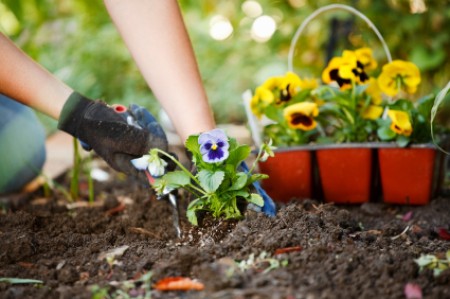
Each spring nurseries and garden centers offer a wide variety of bedding plants. Because many of these plants are already blooming (or nearly ready to), they will instantly perk up your home and garden with color while you wait for seeds and perennials to catch up. Here are some tips to help make the transition from garden center to garden soil as smooth as possible.
The term 'bedding plant' refers to any herbaceous plant that has been grown to blooming or near blooming size before being sold to be planted in the garden. These plants are usually started from seed and grown in a greenhouse and are sold in flats or trays containing 6 to 12 plants, or in 4 to 6 inch pots containing individual plants. The majority of bedding plants are annuals or tender perennials (meant to be treated like annuals), but vegetables may also be grown as bedding plants.
Examples of common bedding plants include begonia, geranium, marigold, impatiens, pansy, and petunias. Tomatoes, peppers, and members of the brassica family are popular vegetable transplants.
Bedding plants are typically planted in masses for their visual impact. Because they are considered "temporary" plants, they are often less expensive to buy than other type of garden plants. Even cheap plants are no bargain if they fail to last, so here are some tips for selecting healthy plants:
Seasonally, most bedding plants can be planted outdoors after danger of frost has passed in your area. Transplanting can be stressful to young plants, so the sooner you can get them into the ground after bringing them home, the better. A calm day with overcast skies is ideal. This allows plants time to recover before being exposed to full-on direct sun.
If it's particularly hot when your seedlings are ready, try to hold off until a cooler time of the day - either morning or afternoon - to lessen the possible effects of transplant shock. If you are unable to set the plants in the ground the day you buy them, put them where they will get good light and keep them watered.
Hardening-Off Greenhouse Plants: Bedding plants purchased from indoor greenhouses or garden centers should not be planted directly into the garden until they have been hardened off. Unlike plants sitting in the open air at big box garden centers and discount stores, plants grown in greenhouse conditions will need a little bit of extra time to acclimate to intense sun and strong winds.
Start by placing the plants in a shady, protected site. Harden the plants by gradually exposing them to sun and wind for increasingly longer periods of time each day. Watch moisture levels closely - watering the plants when the surface of the soil starts to dry. After 7 to 10 days of hardening, your bedding plants should be ready for planting.

About The Author: Ellen Brown is an environmental writer and photographer and the owner of Sustainable Media, an environmental media company that specializes in helping businesses and organizations promote eco-friendly products and services.
Add your voice! Click below to comment. ThriftyFun is powered by your wisdom!
Rather than marking a spot for your plants with a dab of flour, try using a dab of epsom salts. Epsom salts helps root growth. Thank you jerry baker, master gardener, for this tip.
One thing to be aware of is that nurseries typically stock plants that have been "forced" into bloom a little early. While there's nothing wrong with this, you have to realize that when you then plant that rose bush in your own garden it won't bloom as early the next year. We all want instant gratification, but.....
Add your voice! Click below to comment. ThriftyFun is powered by your wisdom!